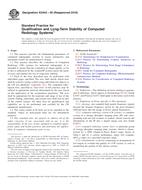Potřebujeme váš souhlas k využití jednotlivých dat, aby se vám mimo jiné mohly ukazovat informace týkající se vašich zájmů. Souhlas udělíte kliknutím na tlačítko „OK“.
ASTM E2445-05(2010)
Standard Practice for Qualification and Long-Term Stability of Computed Radiology Systems
Automaticky přeložený název:
Standardní praxe pro kvalifikace a dlouhodobé stability vypočtených radiologie systémů
NORMA vydána dne 1.6.2010
Informace o normě:
Označení normy: ASTM E2445-05(2010)
Poznámka: NEPLATNÁ
Datum vydání normy: 1.6.2010
Kód zboží: NS-45313
Počet stran: 9
Přibližná hmotnost: 27 g (0.06 liber)
Země: Americká technická norma
Kategorie: Technické normy ASTM
Anotace textu normy ASTM E2445-05(2010) :
Keywords:
ICS Number Code 19.100 (Non-destructive testing)
Doplňující informace
| Significance and Use | ||||||||||||
|
There are several factors affecting the quality of a CR image including the spatial resolution of the IP system, geometrical unsharpness, scatter and contrast sensitivity (signal/noise ratio). There are several additional factors (for example, scanning parameters), which affect the accurate reading of images on exposed IPs using an optical scanner. The quality factors can be determined most accurately by the CR equipment manufacturer tests as described in Practice E2446. Individual test targets, which are recommended for practical user tests, are described for quality assurance. These tests can be carried out either separately or by the use of the CR phantom (Appendix X1). This CR phantom incorporates many of the basic quality assessment methods and those associated with the correct functioning of a CR system, including the scanner, for reading exposed plates and incorrectly erasing IPs for future use of each plate. This practice is for users of industrial CR systems. This practice defines the tests to be performed, by users of CR systems, periodically to evaluate the CR systems to prove proper performance over the life-cycle of the system. Application of Various Tests and Test Methods Tests after Repair, Upgrade or the Use of Another IP Type: Since modifications, such as repair or upgrade of the CR scanner and improved IP may improve the functionality of the system, specialized tests are required to prove the proper performance of the CR system. User Tests for Long-term Stability—Quality assurance in test laboratories requires periodical tests of the CR system to prove the proper performance of the system. The time interval depends on the degree of usage of the system and shall be defined by the user and consideration of the CR equipment manufacturer’s information. The tests described in 6.2.1 through 6.2.6 require usage of quality indicators of 5.1 or the CR test phantom shall be used regularly at user-defined intervals to test the basic performance. The documentation shall contain: (1) Spatial resolution (by duplex-wire method, optional converging line pairs), (2) Contrast (recognized contrast percentage of the material to examine), (3) Slipping (yes/no), (4) Jitter (yes/no), (5) Shading (percentage at selected distance), (6) Radiation parameters of the performed tests, and (7) Date and operator name. Fading tests should be performed only if the scanner or IP-brand is changed without data from the CR equipment manufacturer, or the system is used under extreme (beyond manufacturer’s recommendation) temperature conditions. The fading should be less than 50 % in the expected period between exposure and scan. The IPs shall be checked for artifacts (6.2.7) and proper erasure (6.2.6). Degradation of IPs or photo multipliers in the scanner may reduce the system sensitivity after extensive usage. For this reason, the SNR should be measured at longer intervals (for example, annual period) by the user or service personnel. The SNR shall not be less than 90 % of the original value. The increase of the SNR can be accepted without limits, if the system unsharpness is not increased. |
||||||||||||
| 1. Scope | ||||||||||||
|
1.1 This practice specifies the fundamental parameters of computed radiography systems to assure satisfactory and repeatable results for nondestructive testing. 1.2 This practice describes the evaluation of Computed Radiology (CR) systems for industrial radiography. It is intended to ensure that the evaluation of image quality, as far as this is influenced by the scanner/IP system, meets the needs of users and enables the test of long-term stability. 1.3 Each of the tests described may be performed with individual gages specified. The user shall decide which tests shall be used for system control using individual test objects or the CR test phantom (Appendix X1). The computed radiological tests, specified as “user tests” in this practice, may be utilized at appropriate intervals determined by the user, based on the application of the examination operations. The tests shall be appropriate for the materials and range of use of the system. Fading, uniformity, and erasure tests shall also be part of the control system. All other tests for qualification and capability are to be performed and certified by the CR equipment manufacturer. 1.4 The values stated in SI units are to be regarded as the standard. Values in inch-pound units are for information purposes. 1.5 This standard does not purport to address all of the safety concerns, if any, associated with its use. It is the responsibility of the user of this standard to establish appropriate safety and health practices and determine the applicability of regulatory limitations prior to use. |
||||||||||||
| 2. Referenced Documents | ||||||||||||
|
Doporučujeme:
EviZak - všechny zákony včetně jejich evidence na jednom místě
Poskytování aktuálních informací o legislativních předpisech vyhlášených ve Sbírce zákonů od roku 1945.
Aktualizace 2x v měsíci !
Chcete vědět více informací? Podívejte se na tuto stránku.




 Cookies
Cookies
